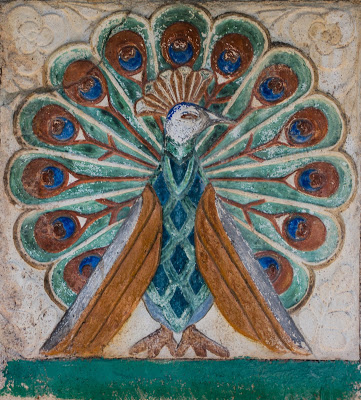Seton had a great fondness for the peacock, making drawings of them and placing a decorative plaque of the bird (probably purchased in Mexico) near the front door of the Castle. Here is Seton’s explanation of depicting THE PEACOCK from Studies in the Art Anatomy of Animals (1896). The short essay is also homage to this beautiful creature. Note that 118 years after its first publication, this book is still in print.
CHAPTER LIV
THE PEACOCK
Plate XLIX
Common opinion has awarded to the Peacock, above all birds, the palm of beauty. Many of the recently discovered Hummingbirds are exquisite, as are the rare Birds of Paradise and some of the Asiatic Pheasants brought to light by modern research, but divested of their charm of novelty, it is found that none of the species mentioned can successfully compete with the Peacock. Probably there is nothing else as beautiful in the world of Zoology.
The train, or ‘tail’ as it is commonly called, is the unique and splendid feature of this regal bird. The chromatic beauties are no less notable than the mathematical correctness with which they are displayed. It is almost unquestionably the most remarkable illustration extant of the regular arrangement of feathers. The perfect geometric design, indicated in the Plate, is not merely hypothetical, but will be seen in every Peacock’s ‘tail’ when in full plumage.
The explanation of this is very simple, as will be seen on reference to the drawing of the naked Sparrow (Plate XLIV.). The true tail of the Peacock, composed of eighteen ordinary feathers, is underneath the train and supports it when spread. The train consists of two hundred and fifty odd posterior feathers of the dorsal tract, which towards the back, together with the radiation when spread, completes the mathematical figure.
A slight variation is sometimes seen when the tail is newly grown. The ends of the three outer rows or Y feathers are close together and separated from the true eye feathers by an exceptionally wide interval. They are also supplied with an embryo eye, which however is soon worn off.



